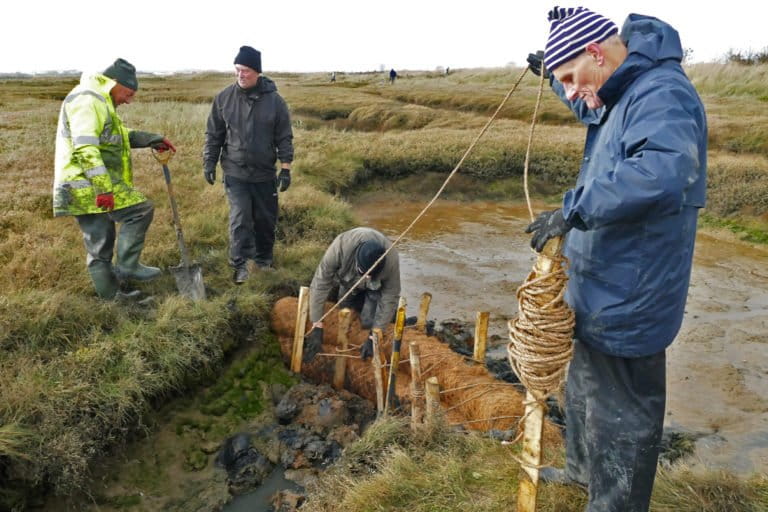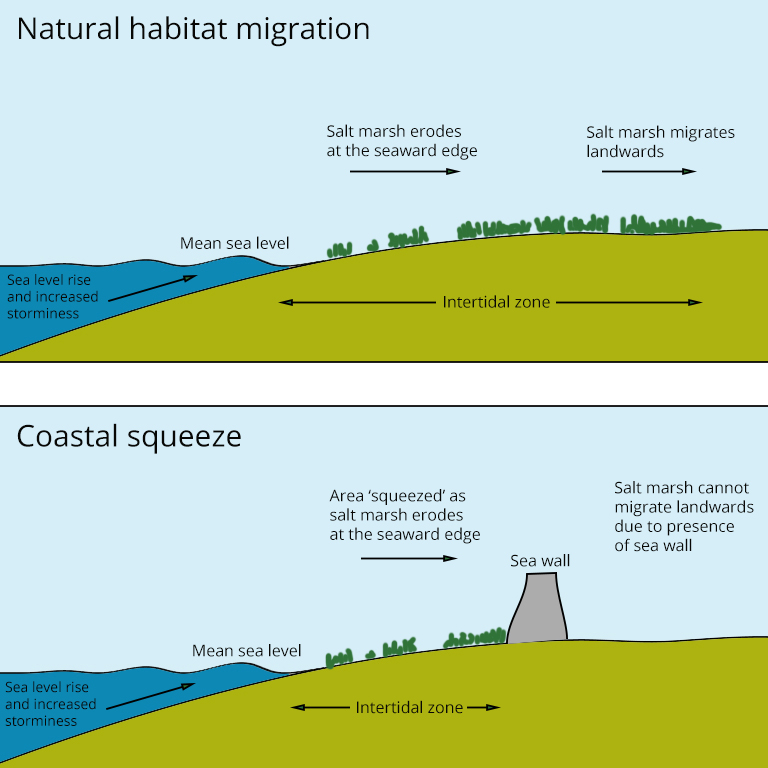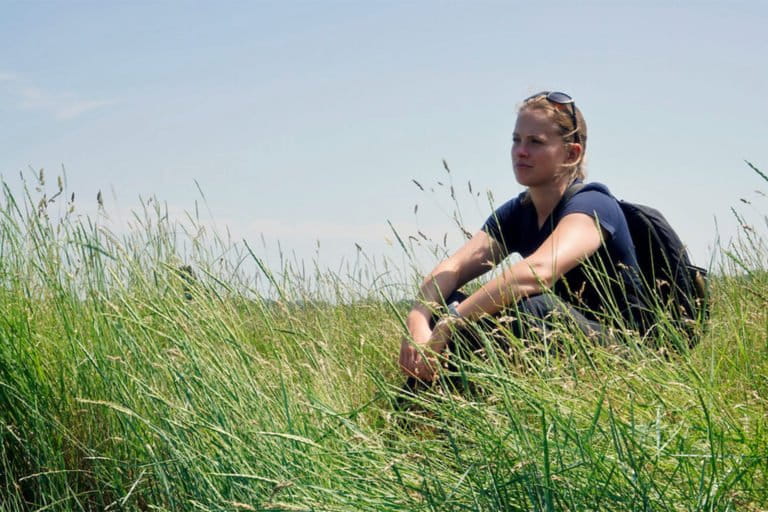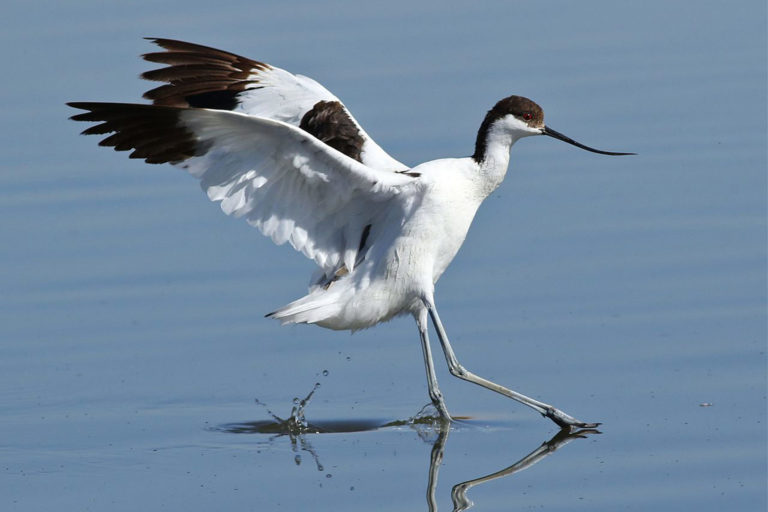- Salt marshes sequester significant carbon in their sediment — more per hectare than tropical rainforests.
- They protect the land from storm surges and sea level rise, and they shelter a variety of birds, fish and crustaceans.
- However, salt marshes are being lost quickly to erosion and development.
- Governments, institutions and researchers around the world are looking into low-cost ways to protect and restore these vulnerable and valuable habitats.
On one of the first dry, hot days of summer, Rachel Langley walks past farmhouses and tractors, heading for the edge of the Colne Estuary in Essex, U.K. She’s on her way to see how her “salt marsh sausages” are doing.
Six years ago, the U.K. government’s Environment Agency broke through the seawalls on the west side of the estuary that dated back to the medieval period. The breach allowed the tide to flow in and create 22 hectares (54 acres) of new salt marsh and mudflats. It was part of the government’s “managed realignment” program to fortify suitable coastal sites against the erosive effects of rising seas and stronger storms that are becoming more common as climate change unfurls.
On the other side of the estuary, however, an existing salt marsh was showing signs of erosion. In 2018, Langley and her team introduced the sausages, 3-meter (9-foot) bundles of coconut coir, to try to stabilize the degrading habitat. Coir rolls are commonly used into restore riverine habitats, and restoration projects, but Langley and her team wanted to test their usefulness in the more energetic estuarine environment with higher energy levels than a river. Could the sausages, installed across narrow channels running through the marsh, help raise the marsh, slow the water flooding it with each tide, and ultimately prevent it from succumbing to the sea?
The chestnut-wood spikes holding stacked coir rolls in place stick out of the fine mud. As Langley approaches, crabs skitter in and out of sight. A successful salt marsh sausage is one you can’t see at all. But while the marsh’s signature low shrubs cover most of the sausages, this one is looking a bit bare. Langley, who coordinates the restoration for the charity that manages the test site, the Essex Wildlife Trust, isn’t too concerned.

“The sediment is accreting, which is good news,” she says, pointing to the green algae taking hold, a sign that pioneer species like samphire (Salicornia europaea) should soon be able to take root.
In the face of climate change, the sausages are among various interventions that researchers are testing for their ability to help protect and regenerate one of the world’s most threatened habitat types.
Salt marshes provide three key benefits to the planet. Like mangroves and seagrass beds, they sequester significantly more carbon in their sediment than tropical rainforests — up to four times more per hectare. They reduce land erosion and property damage from storm surges and sea level rise. And they shelter a variety of birds, fish and crustaceans.
However, their current rate of loss is estimated at 1-2% per year, making marshes one of the fastest disappearing ecosystems worldwide.
Salt marsh restoration has been going on for decades at various scales, and options vary by site. Large-scale interventions include breaking seawalls to bring tidal flows into degraded salt marsh, rebuilding beaches and dunes to create the physical landscape for a marsh to recover, and adding sediment to give marshes more height when they can’t keep up with sea level rise. But these approaches can cost millions of dollars, putting them out of reach for many communities across the world, and not all marshes require such elaborate intervention.
As more research reveals salt marshes’ potential to store blue carbon and protect the land from the incoming sea, governments, institutions and researchers around the world are looking into low-cost ways to protect and restore these vulnerable habitats. The lessons from smaller-scale interventions like the sausages are helping build out a suite of options for addressing various threats marshes face.


Threats to salt marshes
Salt marshes occur in the intertidal zones of cooler climates, covering between 2.2 million and 40 million hectares (5.4 million and 99 million acres) worldwide. The shallow, twisting channels of a salt marsh provide sanctuary for fish nurseries, nesting birds and an abundance of smaller invertebrates, as well as dispersing tidal energy and storm surges. Organic waste from the plants and animals that call the marshes home decomposes slowly in the low-oxygen environment, until it is stored under layers of sediment. When salt marshes degrade, that stored carbon, sometimes centuries old, is exposed and released back into the carbon cycle.
People historically viewed marshes as unimportant wastelands with their low shrubbery and sinking mud, and have often drained them and converted them to upland for construction sites and farmland. Water moving through rivers and estuaries into the ocean often swamps them with pollution.
On top of these historical threats, accelerated sea level rise due to climate change now threatens marshes around the world. With sea levels rising on one side and man-made seawalls, farms or buildings on the other, a phenomenon known as coastal squeeze occurs. The marshes become overwhelmed with salt water, yet cannot expand inland.
These factors have led marshes to decline globally from their historic extent by between 25 and 50%.

A 2018 paper studied changes in the U.K.’s salt marshes in response to relative sea level rise, which includes both oceanic changes, such as increasing water volume due to melting ice caps, and terrestrial changes, such as land subsidence. It concluded that if no change was made to greenhouse gas emissions, nearly all of the U.K.’s salt marshes would have at least an 80% likelihood of retreating inland by 2100. Marshes in areas more prone to subsidence in the south could reach that probability by 2040. And where coastal squeeze prevents marshes from retreating, they’ll be lost to the sea.
“If sea level rise gets to greater than 7.1 millimeters [a quarter of an inch] per year, nine times out of 10, the marshes will retreat,” said co-author Ben Horton, a director at the Earth Observatory of Singapore.
Sea levels have been rising by 3.6 mm (an eighth of an inch) per year in the past decade; the Intergovernmental Panel on Climate Change predicts that rate will increase to 15 mm (0.6 in) per year by 2100 if current greenhouse gas emissions continue.
In the U.K., which has about 18,000 kilometers (11,000 miles) of coastline, sea level rise is an increasingly expensive and urgent challenge. In 2018, the Climate Change Committee reported that more than half a million properties are in areas of significant coastal flood risk. A government report the same year showed that salt marshes can reduce the cost and required height of seawall defenses, underscoring the need for marsh restoration efforts.

Stability from sausages
The Essex Wildlife Trust and the Environment Agency are testing out the salt marsh sausages at two sites in Essex: the one in the Colne Estuary and another in the nearby Blackwater Estuary.
The team installed a total of 30 sausages at the two sites. If they can provide a stable site for vegetation to take hold and sediment to accumulate, they should reduce tidal energy and erosion, both at the edges of the marsh and internally. Langley’s team is working with another from the University of Essex to test whether this is the case.
The teams monitor vegetation establishment and the amount of carbon being stored in the sediment, and they use drone images to assess how the sausages might be affecting the channels and their ability to buffer incoming tides.
Natalie Hicks, a lecturer with the University of Essex, has been collecting and analyzing sediment cores from the site. Alongside dating the carbon, she’s also looking for physical clues in the sediment. So far, the results look promising.
“The coir structures affect the energy and the dynamics within the salt marsh,” Hicks said. “When the tide is coming in, it skims across the sediment surface and moves up the salt marsh. But if you put these barriers in, it takes all the energy out.”
On top of sequestering carbon and defending land from sea, the restored Colne and Blackwater salt marshes in the sausage-test sites and beyond are returning to their natural function as a vibrant wildlife habitat. Wading and wetland birds have returned. Pied avocet (Recurvirostra avosetta), gray plover (Pluvialis squatarola) and shelduck (Tadorna tadorna) have all been spotted in the area. The iconic dark-bellied Brent geese (Branta bernicla) are especially important for attracting tourism from birders.

Fencing to exclude livestock
In Victoria, Australia, Melissa Wartman’s team at the Blue Carbon Lab at Deakin University is studying a different intervention: keeping grazing livestock off salt marsh that’s part of the Victorian Coastal Wetland Restoration Program.
Fencing is an affordable and low-impact intervention commonly used to protect marshes, and it’s showing strikingly visible results here. The program monitors and compares a grazed pasture with two former pastures that have been reverting naturally to marsh behind cattle-excluding fences, one for 12 years the other for two years. The 12-year-old restored marsh is bright with vegetation, and the grazed land covered in low grass.
“It just shows the power of the fence,” Wartman said. “If you prevent cattle from going on and heavily grazing and trampling the salt marsh, it can, if there’s enough of a seedling population, naturally regenerate.”
As with the Essex estuary, hope comes in the form of returning birds. The project has had a victory in the sighting of a rare orange-bellied parrot (Neophema chrysogaster). With fewer than 50 left in the wild, the parrot is at risk of extinction within five years.
The data Wartman’s team is collecting show signs that salt marshes can recover from their conversion to agricultural use.
“Initial results show that because it’s a salty environment, it’s already pretty hard for weeds and other species to colonize, so salt marsh has a pretty good time of coming back as long as the threat and pressure of the grazing isn’t there,” Wartman said.

Herbicide to zap invasive weeds
But weeds do manage to colonize some salt marshes, including the Great Brak Estuary on the southern coast of South Africa.
Smooth cordgrass (Spartina alterniflora) was first observed there in 2004. The species, native to the Americas’ east coast, has been planted for erosion control outside its range, where it often proves invasive. Before 2004, it had never been seen in South Africa, and its discovery in the Great Brak Estuary caused alarm.
“It takes over and outcompetes the less productive estuarine species, so you often have a loss of your native salt marsh species,” said Johan Wasserman, a research assistant at Nelson Mandela University. “It changes food webs and the type of food available.”
The university collaborated with the South African National Biodiversity Institute and a local NGO to control the cordgrass with herbicides over a period of five years. From 24 patches of cordgrass totaling about 1 hectare (2.5 acres), surveys showed the cordgrass had disappeared by 2017, according to Wasserman, who said he saw no sign of it returning during a recent visit to the marsh.

A big toolbox
The herbicide intervention at Great Brak shows how indigenous salt marshes can be saved using existing control methods. Countries around the world are looking for a diverse toolbox of well-studied interventions to protect their salt marshes from sea level rise and extreme weather events — the more affordable and accessible, the better.
Langley said that while it’s still early days, she hopes her sausages will prove useful and can be deployed to stabilize marshes elsewhere.
“We can’t wait for action when it comes to climate change, we need to be innovative and be trialing different approaches now,” she said.
Banner image: The Essex Wildlife Trust team installs salt marsh sausages. Image courtesy of Essex Wildlife Trust.
Correction 9/14/21: This story was updated to correct a quote from Melissa Wartman, who spoke about preventing cattle from “trampling” salt marsh, not “traveling” it as the story originally stated.
Citations:
Mcowen, C. J., Weatherdon, L. V., Bochove, J. V., Sullivan, E., Blyth, S., Zockler, C., … Fletcher, S. (2017). A global map of saltmarshes. Biodiversity Data Journal, 5, e11764. doi:10.3897/BDJ.5.e11764</a
Horton, B. P., Shennan, I., Bradley, S. L., Cahill, N., Kirwan, M., Kopp, R. E., & Shaw, T. A. (2018). Predicting marsh vulnerability to sea-level rise using Holocene relative sea-level data. Nature Communications, 9(1). doi:10.1038/s41467-018-05080-0
Riddin, T., Van Wyk, E., & Adams, J. (2016). The rise and fall of an invasive estuarine grass. South African Journal of Botany, 107, 74-79. doi:10.1016/j.sajb.2016.07.008
FEEDBACK: Use this form to send a message to the editor of this post. If you want to post a public comment, you can do that at the bottom of the page.
